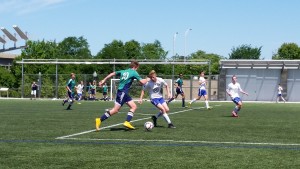United through sport, by the one game the whole world plays
 There are a lot of things the world’s countries can’t agree upon. Thank goodness there is at least one thing we can: the value of sports and physical activity for youth. We like to play. We like to compete. And we like to pass on what we like to our children.
There are a lot of things the world’s countries can’t agree upon. Thank goodness there is at least one thing we can: the value of sports and physical activity for youth. We like to play. We like to compete. And we like to pass on what we like to our children.
I got to see this in a new way last week when I participated in the U.S. Department of State U.S.-China People-to-People Exchanges Sports Seminar entitled, Innovation and Collaboration in Youth Sports and Heath: Global Insights from the United States and China. We convened at the American College of Sports Medicine Convention.
Our conversation centered on physical activity and youth. I was asked to address the prevalence of obesity in our youth and the power of physical activity, sport and exercise to reverse this trend in American children and teens. Maybe you have the same questions I had:
#1: Do we really have a problem with overweight and obesity in American children and teens?
#2: If we are concerned about this issue, are we doing anything to combat it? If so, is what we are doing working?
#3: Is this even a concern for the Chinese?
In fact, yes, yes, and yes. This is a global issue. Here are some of the sobering U.S. statistics:
- Childhood obesity has more than doubled in the children and quadrupled in U.S. adolescents in the last 30 years.
- In 2012, 18% of children aged 6-11 years and 21% of adolescents aged 12-19 years qualified as obese.
- It is estimated that 70-80 % of obese teens will become obese adults.
 Both the US and China are concerned about this in their children and especially their teens. Both point to a decline in physical activity among their youth, coupled with a rise in screen usage.
Both the US and China are concerned about this in their children and especially their teens. Both point to a decline in physical activity among their youth, coupled with a rise in screen usage.
Twelve seems to be the magic age. It is the age where we see the highest risk of dropping out of sports in the U.S., and the Chinese find kids at highest risk for obesity, particularly boys from affluent families.
The Chinese address this concern from the top down. National Fitness was highlighted as a national strategy in 2012, and they have embraced the recommendation shared by both countries that children and youth get 60 minutes of moderate to vigorous physical activity (MVPA) per day. In China they are encouraged to “take exercise in a scientific manner” because it’s good for them. They require this in their physical education classes and even have a fitness requirement as part of their secondary school entrance application.
+READ: Fit2Finish: Why kids’ bodies require special care and attention to stay healthy
We have health and fitness “policy” here in the US and officially recommend the 60 minutes per day of physical activity for our kids, but recommended and required are very different animals. In the US, physical education requirements vary state to state. Some states have no PE requirement. In Virginia, 150 minutes of PE per week, on average, is the target. The gap is huge. Do your kids get 270 additional minutes of vigorous activity outside of PE? And, let’s be honest here, even if they have 4.5 hours of extracurricular practices and games, how much of that time is actually active?
Here’s where China and the U.S. part ways a bit. The Chinese “force” kids to be active. In the U.S. we leave it to the kids and their families to choose. Almost all of the Chinese children meet the requirements. Less than a quarter of U.S. children are even in that ball park.
 By the numbers, the U.S. is failing miserably. Our declaration of independence – including freedom to be sedentary – may just be killing us. Some predict that this generation of children may be the first to have a life expectancy less than that of their parents.
By the numbers, the U.S. is failing miserably. Our declaration of independence – including freedom to be sedentary – may just be killing us. Some predict that this generation of children may be the first to have a life expectancy less than that of their parents.
An interesting observation from Professor Jianjun, my Chinese colleague, was that physical activity in China is high until students reach 20 years old because they are forced to participate by their teachers and it is high after 40 years of age because they are forced to exercise by their doctors. It’s the 20- to 40-year-old age group that is particularly sedentary and at risk in China.
I guess human nature is the same, the world over. You can compel someone to be active, but forcing them to exercise does not make it a lifestyle. Compulsion certainly doesn’t work with the kids I know. I want them to choose to be active. The best way I know, is to make it fun, add a challenge and toss in some healthy competition. Very few people I know choose to exercise because they enjoy the workout. The rest of us do it because we enjoy using our bodies, like how it feels to be fit, and enjoy a great game.
+READ: LeBolt: Plot your course from green to tee
Sure, physical education includes teaching and a bit of skill instruction and assessment. But the best part is the games! That’s what I remember from PE class. There was one game and everyone played. And by everyone, I mean everyone, not just the “good kids” while the others sat on the sidelines to be subbed in. The winning team usually was the one that got a clutch performance from the “weak part “of the line-up.
 I know that doesn’t look much like travel soccer today, where we segregate, select and pare down until we have, say, a national team.
I know that doesn’t look much like travel soccer today, where we segregate, select and pare down until we have, say, a national team.
But I couldn’t help but think, as I looked around the table at the faces from many nations including those of my colleagues from China, that there is just something enticing, perhaps motivating, and even life-giving, about one game that the whole world plays.
Like, for instance, a World Cup. (Nope. I didn’t mention 1999. It’s all about the diplomacy.)
My thanks to the U.S. Department of State and SportsUnited for the opportunity to participate in these conversations and, especially, for inviting me to work with kids from all over the world. We need a common language and they assure me that sport is that language.
SOCCERWIRE MARKETPLACE
- Capital Fall Classic 2025 - Register by October 1st
- Applications are Now Open for the 2026 Jefferson Cup
- Start the Season Strong at Loudoun Premier Cup!
- 50th Annual Rael Vodicka Memorial Tournament
- Soccer Marketing Internships at The St. James FC
- Job Opening: The St. James FC Goalkeeper Academy Coach
- Full-Time Director of Goalkeeping for The St. James FC
- visitRaleigh.com Showcase Series 2025, hosted by NCFC Youth
- Join Official Elite Summer Soccer Camps with Europe’s Top Pro Clubs!
- OFFICIAL BAYERN MUNICH SUMMER CAMPS U.S.











